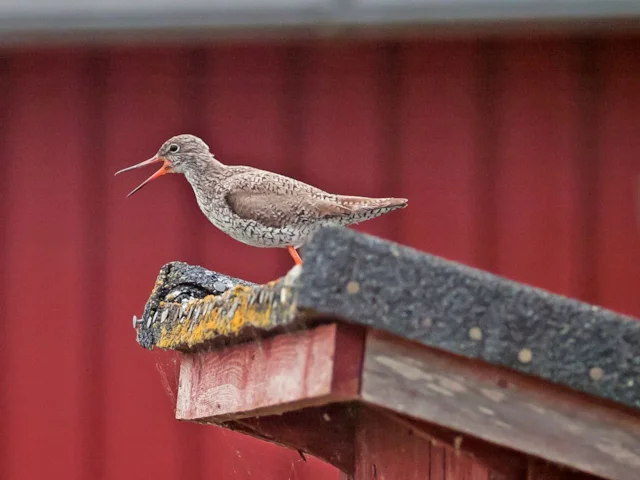Breeding waders on the brink of dying out in Northern Ireland
46ae0e16-6e83-4ba7-91ef-36ee5fb5996d

The populations of Northern Lapwing, Eurasian Curlew, Common Snipe and Common Redshank in Northern Ireland have declined so drastically that they are now in danger of dying out.
A new study into how breeding waders are faring in Northern Ireland (NI) has just been released, and the figures confirm that urgent conservation action is needed if we are to save these species.
The report, co-authored by RSPB NI senior conservation scientist Kendrew Colhoun, is based on the findings of intensive surveys carried out across the country in 2013. It shows that breeding populations of Eurasian Curlew, Northern Lapwing and Common Snipe have declined dramatically since 1987, and the distributions of all species surveyed are becoming increasingly fragmented and restricted towards the western counties of Tyrone and Fermanagh.
The 2013 survey is contrasted with previous surveys undertaken in the same areas in 1987 and 1999, and the findings confirm that the downward trend has continued. To think that these birds, which would once have been considered abundant in NI, have been all but wiped out in a single human generation is hard to comprehend.
Perhaps most worrying is the status of Eurasian Curlew, which now has Near Threatened global status. The estimated population size here in 2013 stood at 526 breeding pairs, a staggering 89 per cent fewer than in 1987. Meanwhile breeding populations of Northern Lapwing and Common Snipe have fallen 84 and 78 per cent respectively in the same period, and as few as 120 pairs of Common Redshank were recorded in the whole of Northern Ireland.
There are many reasons why breeding waders are struggling to survive in Northern Ireland, as well as the Republic of Ireland, Britain and further afield. They are ground-nesting birds which require quite specific conditions to thrive; for example, tussocky grass affords suitable nesting habitat, while wet, invertebrate-rich areas are required for feeding adults and chicks alike.
However, changes in agricultural practices such as increased mowing and drainage, and lack of land management, means many sites suitable for nesting have been lost. Some species, most notably Eurasian Curlew, have been driven into more upland areas where they are more susceptible to predators, which use dense woodland as cover.
Though it might seem that the odds are stacked against these species, science shows that where land is managed appropriately, the number of breeding waders increases. It’s no coincidence that the strongholds for all four species in Northern Ireland are largely on nature reserves or land which is managed by farmers with wildlife in mind.
The RSPB’s recent Halting Environmental Loss Project worked with over 400 farmers in Northern Ireland, and succeeded in increasing the numbers of these species at selected sites across NI by an average of almost 70 per cent. Clearly, now is the time for conservationists and land managers to work together further to try and pull these beautiful birds back from the precipice.
A new study into how breeding waders are faring in Northern Ireland (NI) has just been released, and the figures confirm that urgent conservation action is needed if we are to save these species.
The report, co-authored by RSPB NI senior conservation scientist Kendrew Colhoun, is based on the findings of intensive surveys carried out across the country in 2013. It shows that breeding populations of Eurasian Curlew, Northern Lapwing and Common Snipe have declined dramatically since 1987, and the distributions of all species surveyed are becoming increasingly fragmented and restricted towards the western counties of Tyrone and Fermanagh.
The 2013 survey is contrasted with previous surveys undertaken in the same areas in 1987 and 1999, and the findings confirm that the downward trend has continued. To think that these birds, which would once have been considered abundant in NI, have been all but wiped out in a single human generation is hard to comprehend.
Perhaps most worrying is the status of Eurasian Curlew, which now has Near Threatened global status. The estimated population size here in 2013 stood at 526 breeding pairs, a staggering 89 per cent fewer than in 1987. Meanwhile breeding populations of Northern Lapwing and Common Snipe have fallen 84 and 78 per cent respectively in the same period, and as few as 120 pairs of Common Redshank were recorded in the whole of Northern Ireland.
There are many reasons why breeding waders are struggling to survive in Northern Ireland, as well as the Republic of Ireland, Britain and further afield. They are ground-nesting birds which require quite specific conditions to thrive; for example, tussocky grass affords suitable nesting habitat, while wet, invertebrate-rich areas are required for feeding adults and chicks alike.
However, changes in agricultural practices such as increased mowing and drainage, and lack of land management, means many sites suitable for nesting have been lost. Some species, most notably Eurasian Curlew, have been driven into more upland areas where they are more susceptible to predators, which use dense woodland as cover.
Though it might seem that the odds are stacked against these species, science shows that where land is managed appropriately, the number of breeding waders increases. It’s no coincidence that the strongholds for all four species in Northern Ireland are largely on nature reserves or land which is managed by farmers with wildlife in mind.
The RSPB’s recent Halting Environmental Loss Project worked with over 400 farmers in Northern Ireland, and succeeded in increasing the numbers of these species at selected sites across NI by an average of almost 70 per cent. Clearly, now is the time for conservationists and land managers to work together further to try and pull these beautiful birds back from the precipice.

